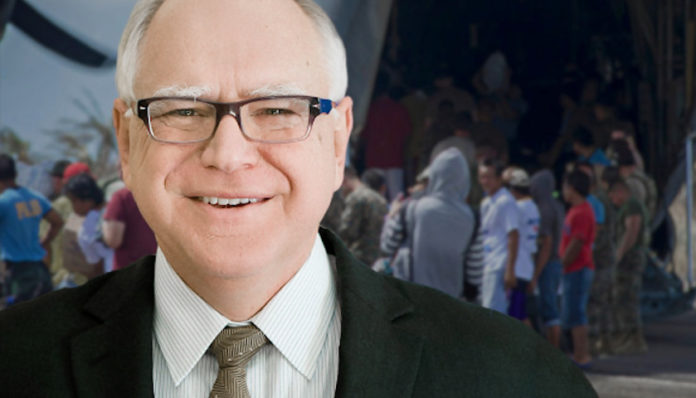Gov. Tim Walz’s December 13 decision to say yes to more refugees in Minnesota grants the federal government permission to resettle refugees from any country it desires into the state, including up to 720 refugees from Middle East countries that the government of Australia has refused to accept.
Press reports indicate these refugees are mainly men who come from Sudan, Pakistan, Afghanistan, Iran, and Iraq.
Because of the Australian government’s refusal to accept these refugees, many of whom reportedly have mental health issues, they have remained housed for several years in refugee camps on the Papua New Guinea island of Manus as well as Nauru, a small island country more than 1,000 miles north of the coast of Australia.
President Barack Obama agreed to accept 1,250 of these refugees in a controversial 2016 deal that President Donald Trump has called “dumb” but agreed to honor. A total of 530 of these refugees have been resettled in the United States under the Trump administration.
Some – possibly all – of the remaining 720 refugees out of the original 1,250 refugees Australia refused to accept also could be resettled in the United States.
In a September 2019 report to Congress, the U.S. Department of State allowed for admitting up to 7,500 refugees “currently located in Australia, Nauru, or Papua New Guinea” pursuant to “an agreement between the United States and Australia.”
Australia has a policy of refusing to take in refugees trying to reach its shores by boat and instead intercepts and detains them in the Nauru or Manus detention centers.
In addition, the federal government could resettle hundreds of refugees in the United States, perhaps more, from countries that have been designated as “hotbeds of terrorism” and are currently among the travel ban countries established by the Trump administration, which now includes Iran, Yemen, Somalia, Syria, Libya, Venezuela, and North Korea. The State Department allows refugees from these countries to seek asylum in the U.S. for purposes of “family reunification,” or simply if they are “referred … by a U.S. embassy in any location.”
A total of 100 refugees from travel ban countries have been resettled in Minnesota since Gov. Walz was inaugurated on January 10, 2019, including seven from Syria and 93 from Somalia. A total of 891 refugees have been admitted to Minnesota during Gov. Walz’s tenure.
The Minnesota Sun contacted Gov. Walz’s office Wednesday and requested a response to the following question:
According to the U.S. State Department’s report to Congress, up to 7,500 of the 18,000 refugees who will be admitted to the United States in FY 2020 could include dangerous refugees from the Middle East currently located in Australia, Nauru, or Papua New Guinea. Was the governor aware of this when he decided to say yes to refugees in Minnesota?
The governor’s office did not reply to the inquiry in time for publication.
An estimated 3 million refugees have been resettled in the United States under the Refugee Admission Program (RAP), which was established under the Refugee Act of 1980 and signed by President Jimmy Carter.
Under that law, the maximum number of refugees authorized to resettle in the United States each fiscal year is determined each September when the president announces a refugee “cap” in a formal presidential determination letter submitted to Congress.
President Obama set the refugee cap at 90,000 in Fiscal Year 2016, the last full year of his administration.
In September 2019, President Trump set the refugee cap at 18,000 for Fiscal Year 2020, which began on October 1, 2019 and ends on September 30, 2020, a reduction from the refugee cap of 22,000 the president set for Fiscal Year 2019.
All of the major candidates for the 2020 Democratic presidential nomination have promised to increase the refugee cap to 100,000 or more, likely greater than a five-fold increase from the Fiscal Year 2020 cap established by President Trump.
In Fiscal Year 2016, 89,995 refugees were resettled in the United States under RAP, 2,635 of whom were resettled in Minnesota.
In Fiscal Year 2019, 22,000 refugees were resettled in the United States under RAP, 848 of whom were resettled in Minnesota.
Since the start of Fiscal Year 2016, Minnesota has resettled 2,246 refugees from countries designated “hotbeds of terrorism” by the Trump administration, including 17 from Iran, two from Yemen, 2,180 from Somalia, and 47 from Syria.
In late September, just days before the start of Fiscal Year 2020, President Trump fulfilled a campaign promise by signing an executive order which said that refugees could not be resettled in a state or locality without the consent of the state government and local government, thereby giving state governments and local county governments the right to refuse refugees for the balance of Fiscal Year 2020.
Bureaucrats at the State Department’s Bureau of Population, Refugees, and Migration have subsequently interpreted that executive order (in a November 6, 2019 guidance letter and “Notice of Funding Opportunity” to the voluntary agencies paid by the federal government to resettle refugees in states) in a way that gives governors alone, rather than full state governments, the ability to send “consent letters” to Secretary of State Mike Pompeo.
Texas Gov. Greg Abbott said no Friday to more refugees in his state, which has been the number one destination for refugees since 2010.
Gov. Walz is one of 42 governors to say yes to refugees, a list that includes every Democratic governor as well as a number of Republican governors, such as Mike DeWine of Ohio, Asa Hutchinson of Arkansas, and Bill Lee of Tennessee.
With the withdrawal of Texas, and possibly Florida, Alabama, Georgia, Mississippi, and South Carolina, from the program, Minnesota stands a good chance of receiving a higher number of refugees during the last eight months of Fiscal Year 2020.
– – –
Anthony Gockowski is managing editor of The Minnesota Sun and The Ohio Star. Follow Anthony on Twitter. Email tips to nagubal.tbpxbjfxv@tznvy.pbz.


















